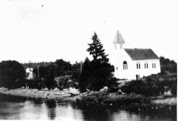As I write this, the Harbor History Museum has a special exhibition of “1987, A Day in the Life Photography Exhibit”…The exhibit showcases a variety of photographs taken in 1987 as a fundraiser for the construction of the lighthouse built at the mouth of Gig Harbor’s harbor. Why the exhibit now in 2013? To remind everyone that the time capsules placed in 1987 will be opened April 26, 2014. Also to allow you to participate in the 2014 fund raising project by purchasing a time capsule to be opened in 2039 and to the “2014, A Day in the Life Photography” project to be exhibited then.
And so, when I ran across an article in the Resource Room that appeared in The Seattle Times on April 17, 1947, I naturally thought. What a great coincidence! Okay, so The Seattle Times was celebrating a different lighthouse. But both lighthouses are in the greater Gig Harbor area: the one connected to the current special exhibit at the HHM, and the other, on Tanglewood Island.
For many years, Tanglewood was known as Grave Island, and was sacred to the Nisqually Indians, who for decades had practiced tree burials by placing their honored dead in dugout canoes high in the fir trees. Later Tanglewood Island became the summer home to Conrad L. Hoska (1856-1910), Tacoma pioneer. When Mr. and Mrs Hoska were sailing one day near Grave Island (at that time called Ellen’s Island by the locals, Mrs. Hoska was so taken with the island’s beauty that she remarked to her husband something like “If I had a million dollars, I would buy that island and make my own personal kingdom.” But she didn’t have to wait for a million dollars as a very short time later Mr. Hoska bought it for her.
In 1933 Dr. Alfred Schultz purchased the island for $8,000. After Dr. Schultz purchased the island according to The Seattle Times article Dr. Schultz said the Smithsonian Institute remove all traceable relics from Grave Island prior to 1891. The name, Tanglewood, was chosen as the official name of the island by the US Board on Geographic Names in 1947. Prior to that it was called by other names besides Grave Island such as Grant Island, Ellens Isle, and Hoska Island. (1)
Dr. Schultz is responsible for building the boys camp on the island’s 18 acres. The camp name Ta-Ha-Do-Wa supposedly means “welcome back to pleasant surroundings.” He is quoted as saying he couldn’t find an appropriate word in the Nisqually language for the camp, so he used a Puyallup tribal word.
Dr. Schultz was a native of Nebraska and taught physical education at the University of Michigan while attending medical school there. He moved to Tacoma in 1927 to complete his internship at Tacoma General Hospital. Schultz had a lifelong interest in health and sports from an early age. He worked at a boys’ camp in Michigan as a youngster, where he was first introduced to canoeing. In 1920-21 he pitched in the Cleveland Indians baseball team (2)
The island is only three miles from Fox Island and Dr. Schultz felt the island should have a lighthouse to symbolize the camp.
Dr. Schultz purchased a Willits canoe for his personal use in the mid-1930s, before the camp was established. Because of his appreciation of the Willits brothers and their canoes he bought their canoes for the camp.But canoeing and its related activities wasn’t the only activity for the boys while at camp. Other activities included tumbling, boxing, tennis, archery, swimming, track and baseball as regular scheduled morning activities. Evening activities included things like fishing, photography, overnight trips story hour and camper/counselor discussion. Optional activities might be rifle, crafts, hikes, volleyball, canoe and boat races.
 |
| Sunday Outting in Willits Canoes though not the Camp TaHaDoWa Campers |
In 1947, the 45-foot lighthouse built of concrete brick and sloping from 18-foot floor diameter to 15-foot roof, stood at the east tip of the island facing Warren across the water. The Seattle Times goes onto say “It’s the first round lighthouse to be built in the US in 85 years. The government approved its design, authorized the installation of a beacon light which will be turned on in June (1947) and consented to changing the island’s name from Grave to Tanglewood.” The lighthouse is no longer functional, but still stands as a historical monument to the island, the camp and Dr. Schultz.
An Island in Time, Growing up in the 1940s by Don Edgers, Page 177-178 has a great recollection of the campers on Sundays when they canoed to Fox Island Congregational Church to attend church from an eight year-old boy as he watched them come and go as well as attending church with them. (3)
 |
| Fox Island Congregational Church |
I couldn’t resist sharing with you The Seattle Times article on Dr. Schultz and his lighthouse. But for much more on Tanglewood Island, you might consider a visit to the Fox Island Historical Museum as their museum keeps alive the history of Fox Island.
(1) The Seattle Times, April 17, 1947
(2) The Willits Brothers and their Canoes, Wooden Boat Craftsmen in Washington State, 1908-1967 by Patrick F. Chapman
(3) An Island in Time, Growing up in the 1940s by Don Edgers, Page 177-178


I read your post and i really like your post.Thank you for sharing this post.
ReplyDeleteTanglewood builders
Price for custom homes in Tanglewood
My book, "A Kid's Kingdom: Growing Up in the City of Destiny" includes a story about my failed singing debut at the Stadium High School Class of '65 Senior Party held on the island. Unfortunately the night of June 11th, 1965 will never be forgotten by me or several of my classmates.
ReplyDelete